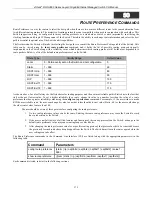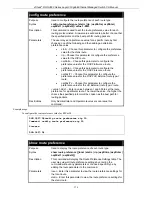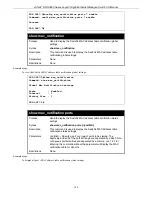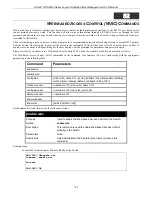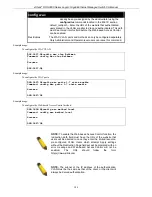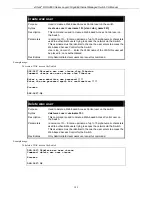
xStack
®
DGS-3600 Series Layer 3 Gigabit Ethernet Managed Switch CLI Manual
370
config ospf ipif
•
simple <password 8>
−
Choosing this parameter will set a simple
authentication which includes a case-sensitive password of no more
than 8 characters.
•
md5 <key_id 1-255>
−
Choosing this parameter will set authentication
based on md5 encryption. A previously configured MD5 key ID (1 to
255) is required.
metric <value 1-65535>
−
This field allows the entry of a number between 1 and
65,535 that is representative of the OSPF cost of reaching the selected OSPF
interface. The default metric is
1
.
state [enable | disable]
– Used to enable or disable this function.
passive [enable | disable] –
The user may select Active or Passive for this OSPF
interface. Active interfaces actively advertise OSPF to routers on other Intranets
that are not part of this specific OSPF group. Passive interface will not advertise
to any other routers than those within its OSPF intranet. When this field is
disabled, it denotes an active interface. The default setting is
disable
. (active)
Restrictions
Only Administrator and Operator-level users can issue this command.
Usage example
To configure OSPF interface settings:
DGS-3627:5#config ospf ipif System priority 2 hello_interval 15 metric 2
state enable
Command: config ospf ipif System priority 2 hello_interval 15 metric 2
state enable
Success.
DGS-3627:5#
show ospf ipif
Purpose
Used to display the current OSPF interface settings for the specified
interface name.
Syntax
show ospf ipif {<ipif_name 12> | all}
Description
This command will display the current OSPF interface settings for the
specified interface name.
Parameters
<ipif_name 12>
−
The IP interface name for which to display the current
OSPF interface settings.
all
– Choosing this parameter will display the OSPF settings for all IP
interfaces on the Switch.
Restrictions None.
Example usage:
To display the current OSPF interface settings, for a specific OSPF interface:




















